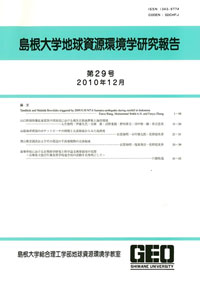島根大学総合理工学部地球資源環境学教室
ISSN:1343-9774

number of downloads : ?
Use this link to cite this item : https://ir.lib.shimane-u.ac.jp/3246
Geoscience reports of Shimane University 18
1999-12-25 発行
台湾および日本列島の古第三系および新第三系の堆積岩のTh,Scおよび希土類元素組成
Th,Sc and rare earth element concentrations ofthe Paleogene and Neogene sedimentary rocks of Taiwan and Japanese lslands
File
Description
Th,Sc and rare earth element concentrations have been examined mainly from Paleogene and Miocene sedimentary rocks of Taiwan and of the Japanese islands.Examined sedimentary sequences are widely located in the Taipei region of Taiwan,Yuya and Susa(Yamaguchi Prefecture),Masuda and Matsue(Shimane Prefecture),Shobara(Hiroshima),Ujidawara(Kyoto Prefecture)of southwest Japan,and Boso(Chiba Prefecture)of Kanto region of Japan.
In Taiwan,the values of Eu/Eu* for the Paleogene and Miocene samples excluding the lowermost sample are consistently around O.6 suggesting evolved continental provenance,very close to those of the present upper continental crust(UC)[Eu/Eu*=0.59].Th/Sc ratios(1.3)show relatively higher values than that of UC,probably due to sorting effect of sedimentary process.The samples from inland basins of southwest Japan(Shobara and Ujidawara)have the composition similar to UC with some variation.Samples of the Yuya,Susa,Masuda,Matsue and Boso areas show stratigraphic variation from primitive to more evolved due to provenance changes related to Japan Sea opening.
The mixing model of UC,basalt(Ba)and granite(Gr)is inferred for provenance signature for these sedimenraty rocks along with previous results.The models revealed provenance variation of the Miocene of Japan sea side from primitive nature(UC:Ba:Gr=60:38:2)of Tohoku region of northeast Japan to more evolved(UC:Ba:Gr=60:2:38)Kyushu region via Chugoku region of southwest Japan.Samples of Taiwan,Kyushu and Yuya form the trend from evolved to more primitive,but lying above the compositional trend of the mixing model probably due to enrichment in Th related to sedimentation on the evolved continental crust.
In Taiwan,the values of Eu/Eu* for the Paleogene and Miocene samples excluding the lowermost sample are consistently around O.6 suggesting evolved continental provenance,very close to those of the present upper continental crust(UC)[Eu/Eu*=0.59].Th/Sc ratios(1.3)show relatively higher values than that of UC,probably due to sorting effect of sedimentary process.The samples from inland basins of southwest Japan(Shobara and Ujidawara)have the composition similar to UC with some variation.Samples of the Yuya,Susa,Masuda,Matsue and Boso areas show stratigraphic variation from primitive to more evolved due to provenance changes related to Japan Sea opening.
The mixing model of UC,basalt(Ba)and granite(Gr)is inferred for provenance signature for these sedimenraty rocks along with previous results.The models revealed provenance variation of the Miocene of Japan sea side from primitive nature(UC:Ba:Gr=60:38:2)of Tohoku region of northeast Japan to more evolved(UC:Ba:Gr=60:2:38)Kyushu region via Chugoku region of southwest Japan.Samples of Taiwan,Kyushu and Yuya form the trend from evolved to more primitive,but lying above the compositional trend of the mixing model probably due to enrichment in Th related to sedimentation on the evolved continental crust.
Other Article
PP. 41 - 54
PP. 85 - 89
